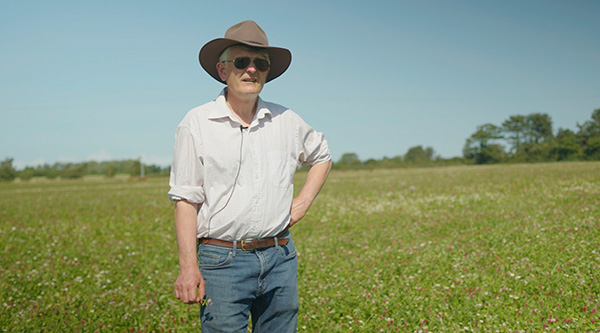

Chris Molyneux is Director of Molyneux Kale Company in the North West of England, growing different types of kale as well as chicory and chard, selling wholesale to food services, restaurants and farm shops.
To successfully grow these hungry crops for years to come, Chris is very aware of the importance of maintaining and enhancing his soil, through crop rotation and soil boosting cover crops from Cotswold Seeds.
His family have been farming the fertile West Lancashire plains since 1850 and after working on the family farm Chris set up on his own in 2013. The land is variable; sandy loam with some clay. Chris says his fields are ‘either soaked or frozen’ due to the weather in this part of the country.
‘Kale seems to like our rainy weather and doesn’t mind the cold,’ he says. ‘However it’s a hungry crop, we need to give the land a break afterwards, so we grow a cover crop to boost the soil. Because we are growing lots of brassicas, we leave this species out of the cover crop. We’ve created a custom mix with plenty of legumes and deep roots’.
At any given time, Chris has 50% of land in cover crops and 50% in kale crops, rotating every two years.
A spring cover crop was sown in May after a winter harvested kale crop. Chris decided not to use any deep cultivations, instead allowing the strong plant roots to do the work. ‘It’s great because I can just leave it. There are a few weeds but the cover crop soon outcompetes them’.
After growing strongly through the summer and providing a flowering haven for bees, Chris decided to further enhance the benefits by leaving the mix to over-winter. He expects the frost susceptible annual clovers to be killed off and die down as a mulch on the surface. The winter hardy red, sweet & alsike clover & ryegrass will survive and grow away strongly in spring.
The next experiment will be to see if strip-till planting into the cover crop in spring 2022 with a kale crop can be successful.
Chris explains: ‘Because you’ve got good structure and a living soil, strip-tilling works so well. You don’t need to work the whole soil surface to get a decent crop. You just need to get the plant into a narrow worked band and nature does the rest.’
‘If we have bare land in autumn we use the Rye & Vetch mix. The forage rye is so vigorous it just takes off, getting to seven feet tall by spring, creating huge biomass, boosting organic matter, while vetch delivers nitrogen for the next crop. Most farmers would take this mix out in March, but this reduces the efficiency of legumes. You need land to warm up to fix nitrogen, so I leave it until early May and sow a kale crop from mid May onwards, this crop benefits from nitrogen fixed in the spring’ explains Chris.
Chris regularly sends his soil to be analysed for nitrogen availability and says the results are amazing. After a two year clover & grass mix, there can be 200-300 kg of available nitrogen.
The cover crops also help with soil permeability. After eighteen months you dig down and there are worms galore. It makes such a difference. One field with higher clay content struggles with surface capping but the permeability created by wormholes and the root biomass give a better quality crop, especially during autumn and winter production.
Date Posted: 2nd November 2022



